Muscle Insider
New member

In today’s world, like many other intriguing topics, Fad diets have also become a prominent and often polarizing topic. While promising quick weight loss and improved well-being, these dietary trends have gained popularity and grabbed the general public’s attention, which is inclined towards these trends mostly based on their research.
People believe fad diets are like shooting starts in nutrition, they might look captivating and eye-catching, but they are not long-lasting – meaning that their effects are short-lived and hence mostly disappointing.
In the age of social media, where trends gain momentum through catchy slogans, celebrity endorsements, and anecdotal success stories, the desire among people to choose Fad diets has increased immensely. These diets are of many kinds based on what change a certain person is targeting.
It includes the elimination of entire food groups or the overconsumption of certain foods or supplements. While the captivating allure of fad diets has its potential risks, they have also proven to address many prevalent conditions such as obesity. While they may prove to be counterproductive in some cases, they also yield fruits in other cases.
Chapter 1: Fad Diet Statistics: At a Glance
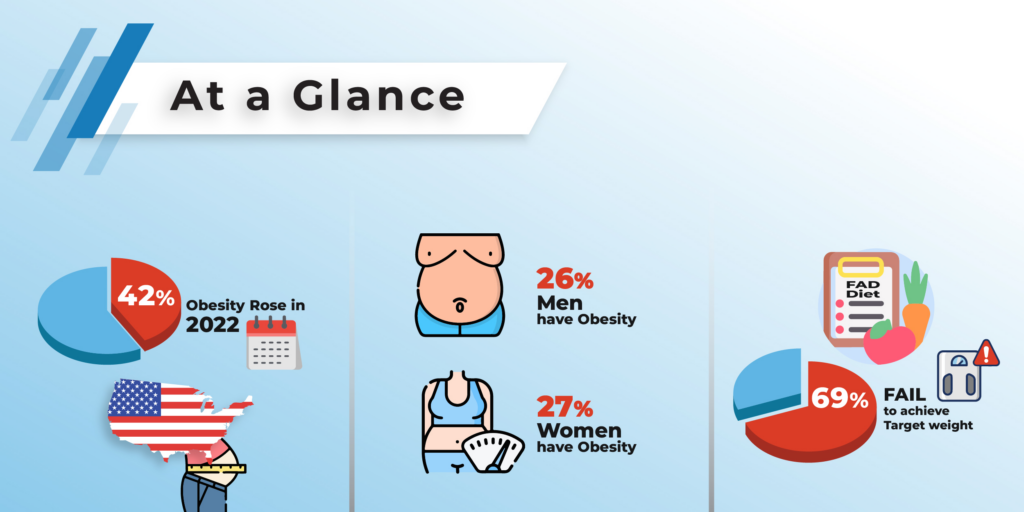
- Fad diets have become very common due to increasing obesity prevalence i.e., In the United States, the rate of obesity rose to 42% in 2022.
- In the UK, 26% of men and 27% of women have obesity and 40% of men along with 30% of women are overweight. Hence, in one survey it was found that 47% of the population, most commonly between age 25-64, were reported to be on diet.
- Mostly, people exercise in combination with Fad diets, which is why 69% of fad diets fail to achieve a target weight.
- The National Health and Nutrition Examination Survey reported that 17% of adults over the age of 20 in the United States were on special diets, among which the most common were Fad diets.
- The number of times an average American tries to lose weight is between 3-10 times.
- A study found that women between the age of 18-49 try to lose weight around 9 times and women over the age of 50 try to lose weight around 11 times.
- In terms of one year time period, 80% of people who commit to Fad diets are unable to maintain their diet behaviors.
- While measuring the span of 5 years, the percentage of relapsed diet behavior rises to 95%.
- Fad diets are also beneficial in some cases. This is because only 5% of weight loss in obese people can bring about positive results, including lower blood pressure and reduced risk of diabetes.
- It has been studied that family income and status also create a direct impact on an individual’s choice to follow Fad diets.
- According to age-wise statistics of Fad diets popularity, it is researched that ages between 20-39 make up 13.3% of the total percentage, ages between 40-59 make up 19.2%, and those above 60 contribute 19.3% to the sum.
- According to one estimate, 86% of Fad dieters cut down high sugar foods and another 85% decide to eat in the way of smaller portions.
Chapter 2: Fad Diet Statistics Around the World
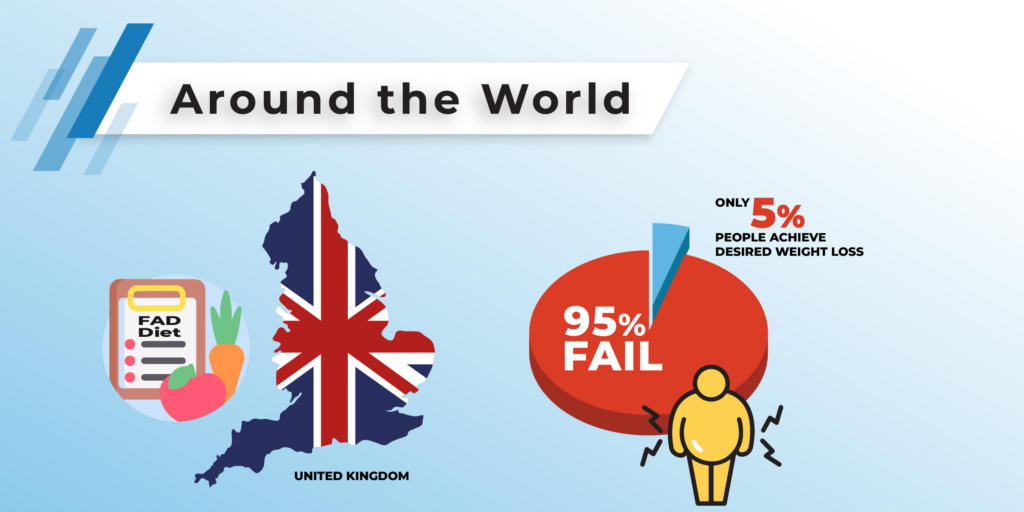
- In the United Kingdom, research found that there is a 95% failure rate associated with Fad diets, and only 5% of people who take Fad diets have long-term achievement of their desired weight loss goal.
- Another astonishing statistic from the UK shows that 40% of people gain more weight than they lose from Fad diets and 12% keep off 75% of the weight they lost.
- In Australia, the research found that young girls who opt for Fad diets at several levels have 18 times the chance of developing eating disorders within 6 months.
Chapter 3: Fad Diet Statistics in the USA
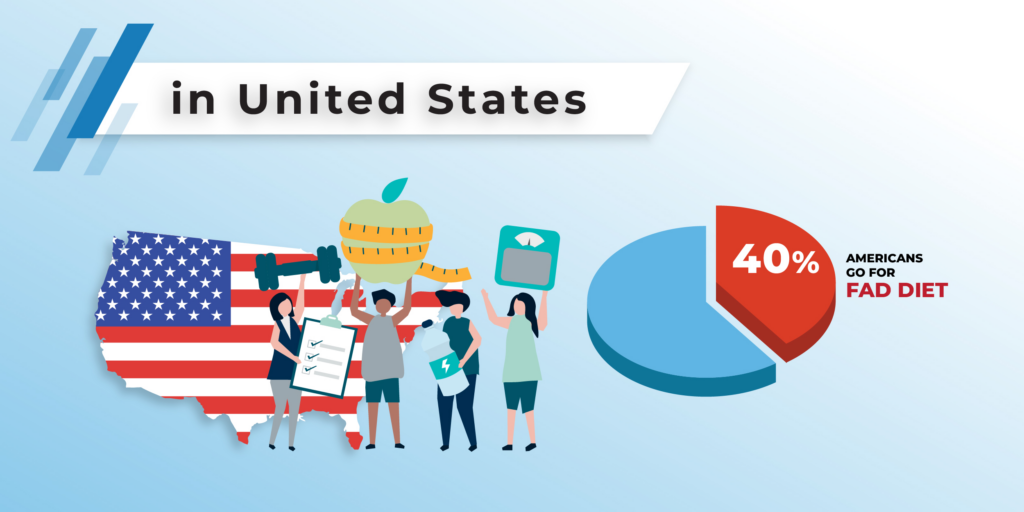
- 17% of Americans claim that they are on a “special diet”.
- Out of 45 million Americans opting to go on a diet, ½ of them choose to turn to Fad diets.
- According to one survey, 40% of Americans go for Fad diets to lose weight over time.
- The unawareness regarding Fad diets in Americans is evident from the fact that 52% of people say that they are confused about diets and 1/5 of them are clueless about the source they should get this information from.
Fad Diet Statistics in the US according to Demographics
- Weight loss and Fad inclination according to race show the following statistics in the United States:
Non-Hispanic Asian41.4%Non-Hispanic white49.4%Non-Hispanic black48.0%Hispanic49.1%
Chapter 4: Fad Diet Industry Statistics
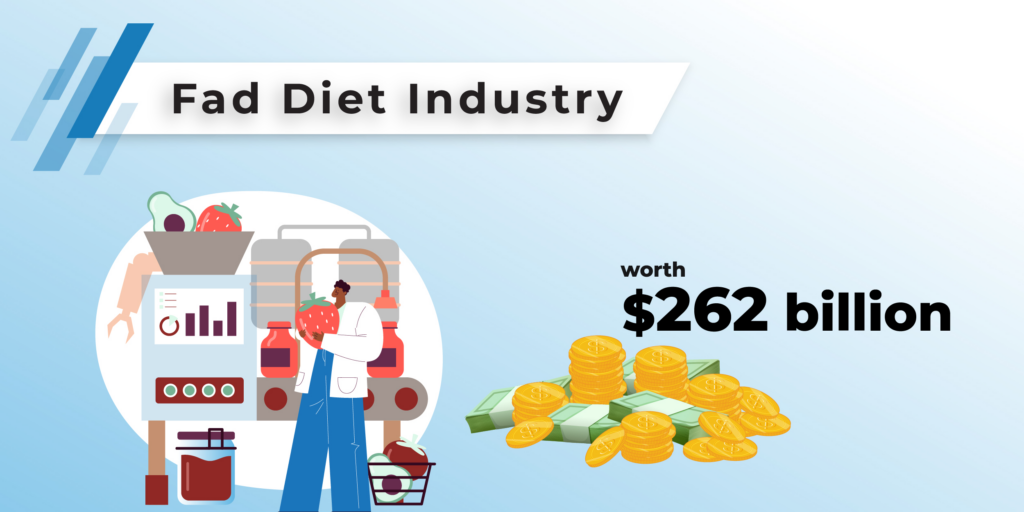
- Fad diets make up a significant portion of the estimated $33 billion that is spent on average by Americans to help with weight loss.
- According to 2022 statistics, the weight loss industry, mainly the Fad diets industry, is worth over $262 billion, and it is expected to grow in the coming years.
- One of the most common Fad diets, the Ketogenic diet is estimated to be worth $1.022 billion in industry and it is expected to increase its worth to $500,000 million by 2027.
Chapter 5: Fad Diet Goals and Types
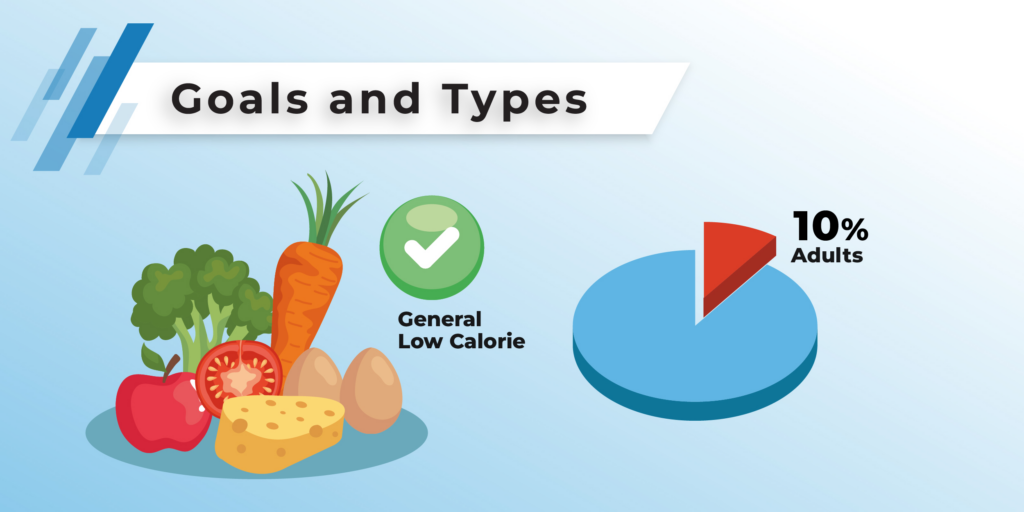
According to one research, Fad diets are designed for targeted calorie intake. Following are stats showing some common diet goals for which Fad are designed and their prevalence in adults:
General low calorie9.3% adultsDiabetic2.3% adultsLow carb2.0% adultsLow fat or low cholesterol1.8%
Chapter 6: Technology and Fad Diets
The prevalence of Fad diets has been accelerated via technology as well.
- It is reported that the number of people using apps and smartphones to track their Fad diet behaviours is increasing. 8% of people use multiple apps, and 6% use physical activity trackers to manage their diet behaviours.
- Studies show that 62% of Fad diet intakes are influenced by interpersonal connections. They also show that 92% of these diet behaviors are influenced by social interactions and media is reported to have influenced 54% of diet behaviors.
- However, 23% of interpersonal support, mainly over media, has helped people maintain their Fad diet routines.
Chapter 7: Common Fad Diets: A Statistical Analysis
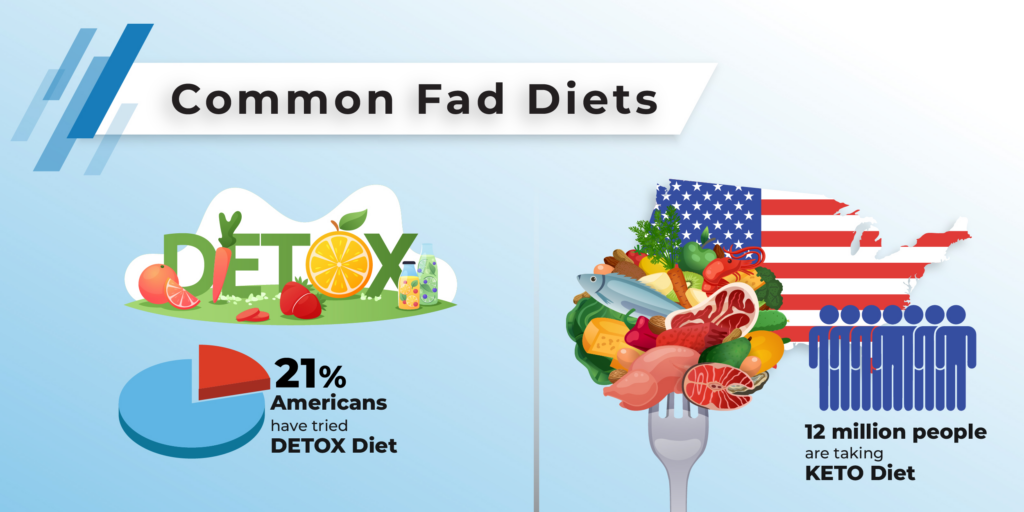
Following are some common Fad diets and their statistical overview:
Atkins Diet
- The Atkins diet is when the consumption of carbohydrates is reduced to 5% of total calorie intake.
- 187 million Americans regularly take low-calorie, sugar-free beverages, and food items in the Atkins diet.
- 8% of Atkins dieters follow a restrictive weight loss plan.
- In the United States, 25% of people have tried the Atkins diet.
- 37% people in the US found Atkins to be very effective, while 46% found it moderately effective.
- 11% of Atkins dieters say that it didn’t work much and 3% believe that it didn’t work at all. In another survey, some 18% even said that they hated the diet.
- Atkins has proved to present 83% success rate in targeted weight loss goals.
Ketogenic Diet
- The ketogenic diet includes moderate proteins (20-25% of calorie intake), low carbohydrates (5-10% of calorie intake) and high fat (65-80% of calorie intake).
- In the US alone, approximately 12 million people are currently taking a ketogenic diet. In Canada keto dieters account for 2% of population.
- According to one study, 19% people follow ketogenic diet. The study shows that 49% keto dieters found it very effective while 35% fond it somewhat effective.
- 8% keto dieters believe that it is ineffective while 3% are adamant that it is not effective at all.
- Other reservations regarding ketogenic include; 37% people believing it is too strict, 34% complaining that it is too expensive, 24% stating that its too time taking, 10% stating that it is confusing and 12% concluding that it shows no results.
- Keto is one of the most common Fad diets, yet 70% people choose it based on their own research and less than 5% choose it according to doctor’s recommendation.
- 85% of ketogenic dieters seek guidance from internet.
- 80% of keto dieters are likely to recommend it.
- 65% of keto dieters noted that they didn’t require a change in exercise routine while 27% felt the need to increase exercise.
Mediterranean Diet
- The Mediterranean diet accounts for 30% polyunsaturated fatty acid (PUFA) and monounsaturated fatty acids (MUFA), 50–55% carbohydrates, and 15–20% of calories of proteins in total calorie intake.
- According to one study poll, the Mediterranean diet reduces cardiovascular disease by 25% and chances of stroke by around 30%.
- The Mediterranean diet has been proven to promote healthy aging by improving cellular health.
- Another survey shows that 18% of Americans have tried the Mediterranean diet. 37% of these dieters found it very effective while 44% found it effective. 12% maintained that it wasn’t very effective and 1% refused that they were effective at all.
Paleo Diet
- Paleo dieters source claims that one can lose 4-6% of total body weight in 10 weeks through the paleo diet.
- The paleo diet provides 50% less calcium intake than needed on average.
- 91% of white people account for the total paleo dieters’ number and 55% of them are females. 77% of paleo dieters are highly educated with a four-year or higher degree.
- The paleo diet has also proven effective in reducing blood pressure by 15-19 mmHg and cholesterol levels by 39%.
- Another study found that 3% of paleo dieters later convert to the Mediterranean diet, 10% shift to the ketogenic diet and 1% become vegetarian.
Vegetarian Diet
- 15% of Americans have tried vegetarian diets and 5% identify as vegetarians.
- Out of this, in terms of weight loss, only 33% found it to be effective and 46% found it to be very little effective with 18% stating that it is ineffective in weight loss.
Intermittent Fasting
- Intermittent fasting has a high dropout rate of 65% and it is 9% higher than calorie-reducing diets.
- A meta-analysis conducted on intermittent fasting shows that it leads to 0.8% to 13% body weight loss.
- Intermittent fasting became one of the most searched terms on the internet in 2019.
- In one poll conducted in the United States, it was found that 24% of people have tried intermittent fasting and 50% of these people claimed that it was very effective. 37% found intermittent fasting to be somewhat effective while 8% said it was ineffective and some 3% claimed that it was very ineffective.
- A survey shows that 80% of people have awareness related to intermittent fasting even if they have not tried it themselves.
Detox Diet
- According to the International Food Information Council, the detox diet is the least common Fad diet with less than 3% of all people regularly on a Detox or Cleanse Diet.
- Approximately 21% of Americans have tried a detox diet once at some point.
- 86% of all people who have chosen a detox diet and experienced it found it at least somewhat effective
Chapter 8: Fad Diets and Associated Health Risks
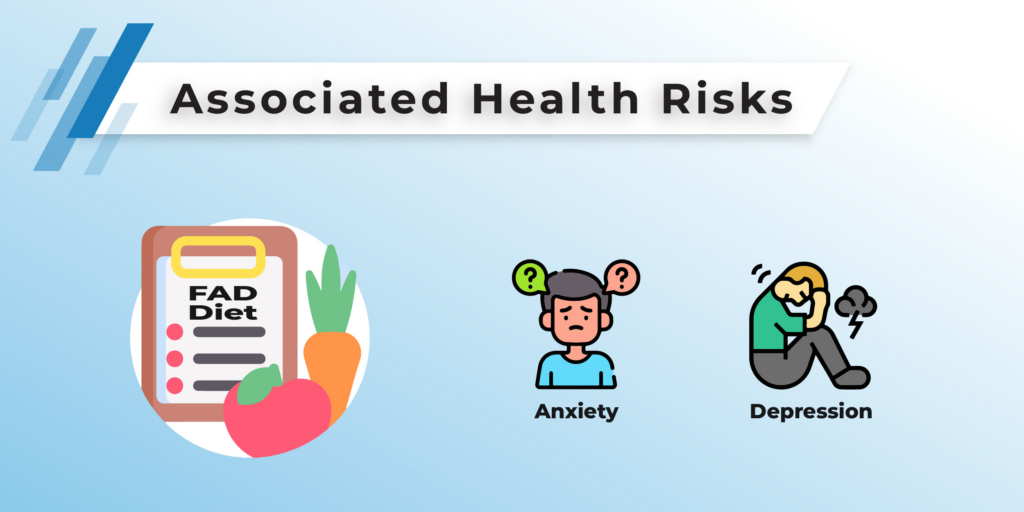
- Weight gain is a counterproductive health risk related to Fad diets where 65% of individuals regain weight more than they lose.
- Some common side effects of Fad diets include feelings of anxiety and depression. In the United Kingdom alone, 15% of people who intake Fad diets have experienced similar health risks.
- In the United Kingdom, 1.25 million people developed eating disorders after Fad diet intake, contributing to another health risk.
According to one study, the following is an overview of the most common health risks associated with Fad diets:
Constipation due to the absence of fiber-rich foods68% riskBad breath63% riskHeadache51% riskHair loss10% riskIncrease in menstrual bleeding3% risk
Conclusion
In a world where nutrition has become an important discussion, fad diets continue to capture our attention, with their glittering promises of rapid weight loss and better health. However, it is important that one not get overwhelmed by the fleeting nature of these diets because the allure of quick fixes often overshadows the importance of sustainable, evidence-based nutrition.
If these diets are taken unsupervised and are not consulted for property, they are believed to cause nutritional deficiencies, muscle loss, and harmful yo-yo dieting cycles, resulting in negative health consequences.
Moreover, these might look easy to jump to, but the dropout rates of most common fad diets show that achieving consistency in fad diets is a difficult task. Hence, it is a call to prioritize balanced, long-term dietary choices by consulting healthcare professionals.
Click here to view the article.









